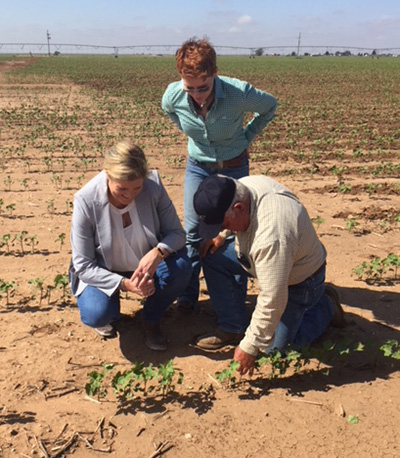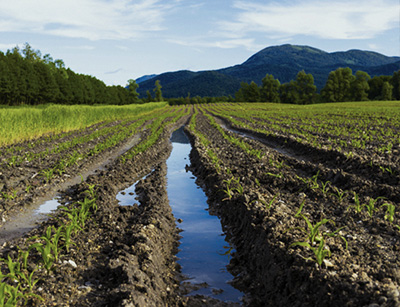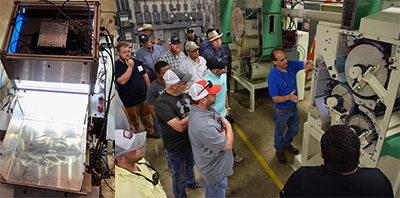Regulatory
The NCC submitted comments to USDA’s Natural Resources Conservation Service (NRCS) on the agency’s interim final rule on “Highly Erodible Land and Wetland Conservation.” The comments suggested many ways in which the NRCS could clarify the regulations for farmers while more closely aligning their regulation with the statute and Congressional intent.
The NCC joined 37 other organizations in the American Alliance for Innovation on a letter to Senators in support of EPA Acting Administrator Andrew Wheeler to serve as Administrator – saying that Wheeler would carry on the Trump Administration's plan for common sense, scientifically-supported regulations. Soon after the nomination, the Senate voted 52-47 to confirm Wheeler in that post.
The Pesticide Policy Coalition, of which the NCC is a member, submitted comments to EPA regarding a petition from the Center for Food Safety (CFS) seeking revisions to testing requirements for pesticides prior to registration. Among points emphasized was that CFS’ actions would go against Congressional intent when it created the Federal Insecticide, Fungicide and Rodenticide Act (which does not include duplicative testing).
The NCC attended the ceremonial swearing-in of Alexandra Dapolito Dunn as the new assistant administrator of EPA’s Office of Chemical Safety and Pollution Prevention. Dunn oversees EPA’s pesticide program and the work on identifying chemicals that are subject to the requirements of the Toxic Substances Control Act. In early-summer, Dunn and other EPA staff visited three cotton farms, a gin, a warehouse, and a cottonseed oil mill in the Lubbock area while accompanied by local cotton industry members as well as NCC and Plains Cotton Growers staff. The EPA officials also participated in a meeting with producers and cotton research and Extension staff that included discussion of: 1) specific insect, weed, and nematode pests, 2) specific pesticides, and 3) issues faced by EPA as it tries to fulfill a mission of protecting human health and the environment while providing tools for farmers to be successful in growing fiber, food, and feed.

The NCC filed comments with EPA on their proposed guidance document for conducting Endangered Species Act (ESA) biological risk assessments for species potentially affected by pesticides that are under review. While the NCC applauded EPA’s efforts to relieve a regulatory bottleneck that continually threatens the availability of all pesticides, the NCC noted that many of the agency’s proposed ideas were overly conservative and would unnecessarily slow the process down. The NCC followed this process and engaged with EPA and other agencies as needed.
NCC staff participated in a Congressional Western Caucus (WC) roundtable discussion that was followed by the unveiling of a draft legislative package comprised of 19 bills intended to modernize the ESA. The NCC and other stakeholders provided clear examples of how and why the current ESA implementation was not working for the species the law was intended to protect or the agricultural producers, rural communities and businesses that it harms in the process. The NCC later sent a letter to the WC supporting the draft package of 18 separate bills which had been expected to be introduced early in 2020.
The NCC issued a news release in which it conveyed its appreciation for EPA’s proposal to change some aspects of the Worker Protection Standards finalized under the last Administration. The proposed revisions would: 1) modify the Application Exclusion Zone (AEZ) to be enforceable only on the farmer’s property; 2) exempt immediate family from having to leave their homes or outbuildings; 3) clarify that applications can resume as soon as an individual has vacated the AEZ; and 4) simplify the decision-making process on whether the AEZ must be 25-feet or 100-feet. NCC Chairman Mike Tate stated that, “I believe these changes, when finalized, will provide much-needed assurance to farmers and applicators, reduce their potential liability, eliminate the loss of useable field edges and still protect human health and the environment.”
Allen McLaurin, a North Carolina cotton producer who represents the U.S. cotton industry on EPA's Pesticide Program Dialogue Committee, was involved in that panel’s discussion of such items as funding for EPA's office of pesticides, future pesticides for hemp, disaster response, bio stimulants, and pesticide applications by unmanned aerial vehicles.
WOTUS
The U.S. Army Corps of Engineers and the EPA published the “Revised Definition of ‘Waters of the United States’” (WOTUS) in the Federal Register. After reviewing the document, the NCC, joined by 25 affiliated industry groups, submitted comments to EPA and the Corps. Among points made were the need for the rule to strengthen the prior converted cropland exclusion with the idea that “ditches” and “impoundments” didn’t need their own categories.
The NCC monitored this issue. That included a Texas District court ruling in mid-2019 that the Obama Administration's EPA violated the Administrative Procedure Act (APA) when forming its version of the WOTUS rule. Specifically, the court found that the EPA did not uphold the notice-and-comment portion of the APA when it did not allow for comment on drastic changes that appeared in the final rule but not in the proposal.
After attending the EPA/Corps signing of a repeal of President Obama's 2015 WOTUS rule, the NCC issued a statement in which NCC Chairman Mike Tate noted that "cotton producers and all of agriculture deserve a commonsense and understandable rule that not only ensures environmental and human health but protects farmland and our rights to conduct our operations in a responsible and economically sustainable manner with flexibility that wasn’t present under the 2015 rule.”
The repeal was scheduled to go into effect on December 23, 2019, and the NCC continued to follow the rulemaking process, including the proposed replacement final rule.

Crop Protection Product Support
The NCC continued to engage EPA on crop protection product registrations and other regulatory matters that affect efficient cotton production.
The NCC filed comments with EPA regarding treated seeds. The NCC also participated in the comments submitted to EPA from the Pesticide Policy Coalition on this issue which it monitored throughout 2019. The comments emphasized that 1) there was no benefit gained by duplicating the registration process for the article (seed) after it has been treated as labeled with a registered pesticide and 2) the loss of the “treated article” exemption likely would end utilization of treated seed.
EPA, which determined that glyphosate is “not likely to be carcinogenic to humans,” published its human health risk study for glyphosate for public comment. Soon after, the NCC filed comments to the EPA in response to the publication of its “Glyphosate Proposed Interim Registration Review Decision.” The comments discussed the need for effective weed management using a variety of tools, including the increasing use of glyphosate and transgenic cotton varieties tolerant to glyphosate applications.
EPA also issued guidance regarding labeling of glyphosate products stating that the agency would no longer approve product labels claiming that glyphosate was known to cause cancer. Mark McKean, a California cotton producer, NCC director and American Cotton Producers member, stated, “I and my fellow cotton growers around the country applaud EPA’s willingness to stand behind their science, and the science of so many other groups, to assure the public that glyphosate does not pose a cancer risk.”
Later, the Food and Drug Administration published results from its annual Pesticide Residue Monitoring Program that determined all glyphosate residue levels detected were below the safety tolerances established by EPA and that several commodities had no detectable residues at all.
The NCC filed comments on EPA's Proposed Interim Registration Review Decision for Buprofezin (trade name Courier). The NCC took issue with EPA's consideration of requiring coarse droplet sizes for insects that reside on the underside of cotton leaves. The NCC also urged the agency to work with USDA on obtaining scientific data that evaluates the impact of various droplet sizes on insecticide product efficacy, so the agency could understand the lack of effect it might have on aphids and whiteflies.
The NCC issued a statement saying it was grateful for EPA’s decision granting use on cotton of sulfoxaflor (commercially known as Transform©) – a uniquely designed insecticide that targets piercing/sucking insect pests such as aphids and plant bugs. NCC Chairman Mike Tate said that EPA had been diligent in requesting new studies of sulfoxaflor use on cotton and other crops – efforts that provided additional data for the agency’s scientific review per court order.
Biotechnology
Throughout 2019, the NCC continued to follow developments regarding biotechnology.
That included President Trump's issuance of the executive order, “Modernizing the Regulatory Framework for Agricultural Biotechnology Products.” That order directed the Food and Drug Administration, USDA and EPA to review their respective agricultural biotechnology regulatory systems for streamlining processes and removing overly burdensome regulations.
The NCC submitted comments to the Animal and Plant Health Inspection Service (APHIS) regarding its latest proposal to revise and reinvigorate the Part 340 rules on the introduction and release of new genetically engineered organisms. While the NCC largely agreed with the new proposal, it disagreed that the relatively new science of gene editing should be classified as genetic engineering due to the amount of regulations and negative public opinion that will ensue as a result. The NCC's comments also suggested that a new self-determination process for new traits should have a mandatory review by the agency to ensure accuracy and transparency in the regulatory process.
The NCC also submitted comments to APHIS supporting the deregulation of MON 88702 - a cotton plant genetically engineered for resistance to certain insects, primarily Lygus spp.
Cotton Flow and Packaging
The NCC was active on several fronts throughout the year addressing issues affecting the timely movement of baled cotton fiber to domestic and foreign customers; the acceptance of materials used to package U.S. cotton fiber; and the development of new, innovative packaging materials and techniques.
The Joint Cotton Industry Bale Packaging Committee (JCIBPC), chaired by Ben Evans, a Georgia ginner, granted a product approval request and two requests for continued testing of packaging products. Full approval was granted by the JCIBPC for Dubose’s strapping system. PAC Strapping was granted approval to continue its compatibility testing of polyethylene terephthalate (PET) strap on patented p-weld friction technology® systems. L.P. Brown’s light-weight cotton bale bag was approved for continued testing. PAC Strapping’s second year PET compatibility test was granted a “JCIBPC determination” in order for bales in the test program to be deemed “deliverable” in accordance with Intercontinental Exchange (ICE) Cotton No. 2® rules.
The JCIBPC approved the revised 2019 Cotton Bale Packaging Specifications – later approved by USDA – that included a new requirement for all woven plastic bagging to include a UV inhibitor in the bagging’s coating.
The NCC distributed a news release in which it stated that policies which were included in the USDA Cotton Storage Agreement are aimed at enhancing the industry’s reputation for timely delivery by getting U.S. raw cotton into customers’ hands faster. Those policies – which were based on NCC resolutions regarding warehouse bale shipment reporting – called for warehouses to 1) report their weekly shipments electronically in a more detailed manner and 2) respond promptly to shipping orders from merchants via computer.

The NCC joined numerous agricultural organizations on a letter to the Surface Transportation Board (STB) regarding demurrage and accessorial charges imposed by railroads. The letter 1) noted that in some cases, language imposed by carriers in their conditions of carriage appear designed to have a chilling effect on rail customers that otherwise attempt to challenge charges that are inaccurate or excessive and 2) supported STB Chairman Ann Begeman’s decision to increase the transparency on the additional significant revenues that were being generated by the Class I railroads.
Later, the NCC joined other cotton organizations and numerous other agriculture and business groups on two letters to the STB. One letter, organized by the Rail Customer Coalition, of which NCC is a member, commended the STB’s Rate Reform Task Force for taking bold action in outlining serious reforms to how the STB reviews excessive freight rail rates. The other letter, organized by the Agricultural Transportation Working Group, of which NCC is a member, conveyed appreciation of the creation of the STB’s Rate Reform Task Force which developed ideas that could lead to modernizing and improving the agency’s rate-challenge process to make it more accessible to rail customers.
The NCC filed comments on the Federal Motor Carrier Safety Administration’s (FMCSA) advanced notice of proposed rulemaking regarding the statutory exemption from Hours of Service requirements for drivers transporting agricultural commodities “during planting and harvesting periods, as determined by each State.” The NCC’s comments 1) supported leaving in place the current definition of “agricultural commodity” which refers to any agricultural commodity, non-processed food, feed, fiber or livestock and 2) emphasized that the definition allowed the cotton industry to transport its products throughout the supply chain.
Later, the NCC carried a Cotton’s Week article regarding FMCSA’s announcement that it was establishing the Commercial Driver’s License (CDL) Drug and Alcohol Clearinghouse that will include CDL drivers who drive any commercial vehicle, including those who haul cotton modules, bales, cottonseed and other cotton products.
The NCC submitted comments to the Department of Labor (DoL), Employment and Training Administration and Wage and Hour Division’s Notice of Proposed Rulemaking on proposed changes to improve the H-2A temporary agricultural labor certification program. The proposed changes would modernize the Department's H-2A regulations in a way that is responsive to stakeholder concerns and enhances employer access to a legal source of agricultural labor, while maintaining the program's protections for the U.S. workforce and enhancing enforcement against fraud and abuse.
The NCC and the interest organizations representing the industry’s warehouse and marketing segments stayed in close communication with USDA leadership about 1) a planned approximate 10 percent increase in fees associated with the U.S. Warehouse Act (USWA) licensed warehouses for numerous commodities, including cotton and cottonseed and 2) the importance of minimizing program costs to limit the need for repeated fee increases on a frequent basis. The NCC also joined onto a letter to a Senate Appropriations Committee subcommittee in support of USDA’s budget request for funding to update and modernize the IT systems necessary for the USWA and warehouse services functions. The NCC continued to work closely with USDA to ensure a well-functioning warehouse system that is administered efficiently as possible to limit the need for future fee increases.

Research and Education
The NCC joined nearly 60 other industry groups on a letter to the chairmen and ranking members of the House and Senate Appropriations Committees’ subcommittees on Agriculture, Rural Development, Food and Drug Administration, and Related Agencies requesting $445 million in the FY20 budget for USDA’s Agriculture and Food Research Initiative (AFRI). The letter emphasized that the 1) United States has lost its position as the top global funder of public research and development and 2) requested AFRI funding level would support research that strengthens rural economies, improves public health, and enhances the United States’ ability to compete in a global economy.
Continuing its educational activities on lint contamination prevention, the NCC strongly urged producers and gin managers to have their entire harvest and ginning crews watch the updated NCC-produced “Prevention of Plastic Contamination” video. The National Cotton Ginners Association (NCGA) also conveyed this message at its three 2019 Ginner Schools. Among new topics that were incorporated into the video were: 1) what to do with round module wrap rolls once they are empty and 2) synchronizing module truck bed-chain speed with the ground when picking up modules.
After reports from textile manufacturers indicated that PET strap had become a significant contamination source, the NCC reminded gins to perform recommended maintenance and adjustments on strapping systems before beginning the ginning season and 2) monitor performance throughout the season to help ensure contamination-free lint. The gins also were urged to watch for other potential contamination sources prior to the 2019 harvest and ginning season.
Another contamination prevention initiative was the NCC Board’s vote to accept a recommendation from the NCC’s Quality Task Force involving changes in the reclass procedures for bales with a 71/72 call. It stated, “Due to the negative impact of plastic contamination on the marketing of U.S. cotton in the global and domestic market, it is recommended that beginning with the 2020 crop any U.S. bale designated as 71 or 72, either during the initial classification or upon re-classification, retain that designation. Further, to promote lint quality transparency and stewardship, it is recommended that producers and ginners refrain from re-classing 2019 crop bales designated solely as 71 or 72.”
The NCC-coordinated 2019 Beltwide Cotton Conferences in New Orleans attracted 1,013 attendees to the forum’s 10 technical conferences and Cotton Consultants Conference. The NCC also began providing unrestricted access to the BWCC proceedings to better facilitate research and educational efforts within the U.S. cotton industry. Dr. Eric Hequet, a former cotton breeder and chair of Texas Tech University’s Plant & Soil Science Department, was recognized at the forum on being named the 2018 Cotton Genetics Research Award recipient.
Among other research and education activities:
• the NCC cooperated with the NCGA on the three well-attended 2019 Ginner Schools – the Western Ginners School in Las Cruces, N.M.; the Stoneville Ginners School in Stoneville, Miss.; and the Southwest Ginners School in Lubbock.
• Don Cameron, a California diversified producer and former NCC director, testified before a House Agriculture Committee subcommittee regarding 1) the increased yields and reduced costs that resulted from his use of precision agriculture/irrigation, 2) the importance of USDA conservation programs, and 3) the need for rural broadband.

